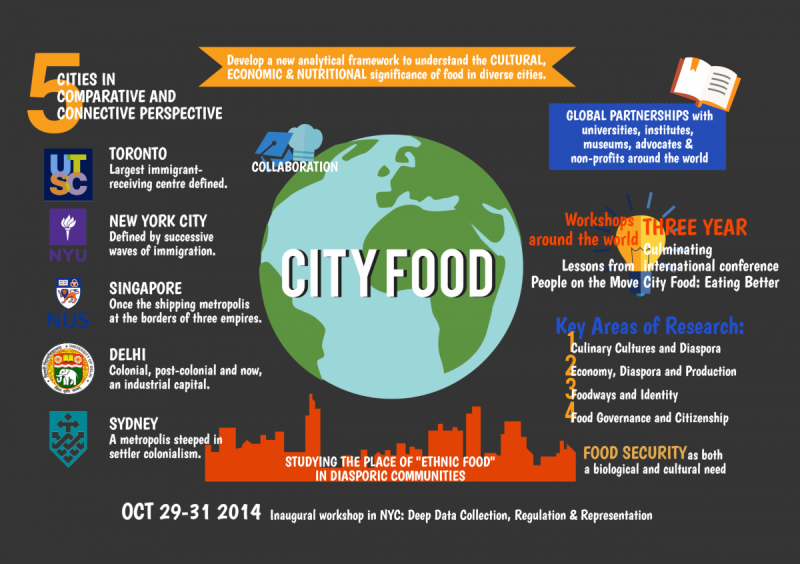Cities must be well-fed. Food is essential for their economic viability, residents’ health, and social vitality. Food is equally important for the expression of ethnic and diasporic community, the regulation of safety and nutrition, and the creative search for life and livelihood. Well-fed means more than sufficient calories. In this last century of global migrations, the diversity of foods produced, consumed, and sold in expanding cities has increased dramatically. Food studies, too dependent on the encompassing label of ‘ethnic foods’, misses the way food is weaved into the physical, psychic, and economic fabric of cities. Equally, urban studies scholars and policymakers have used ‘ethnic food’ merely as a symbol of the diversity of our target research cites, but overlook its economic and cultural centrality.
The scholarship of food studies deserves a central place in conversations around local, national, and global equity. At a time of increased human mobility and urbanization, the necessity of providing not only sufficient and nutritious calories but also foods linked to diverse populations’ varied traditions and backgrounds becomes a pressing global challenge. Our project examines how behind the much-studied touristic pleasures of ethnic food, lies economic disparity and cultural alienation. Our research deepens the meanings of ‘food security’ by understanding security as both a biological and cultural need and recognizing that, for some, food is a source of pleasure while for others, it is a living. For all, how we eat produces identities.

Following recent calls to situate cosmopolitan eating and ethnic foodways in historical and political context (Iacovetta et al. 2012; Liu 2009; Mannur 2005; Padoongpatt 2011), this partnership examines the historical transformation of cities as disparate groups have come together in ever closer spaces and practices of everyday life. We have selected five cities represented – and marketed to business, migrants, and tourists alike – as multicultural metropoles. Toronto, once a meatpacking hub at the crossroads of the British empire and the United States, has emerged in the last quarter century as the largest immigrant-receiving centre in a country increasingly defined by its diasporic communities (Baker 2004; Barndt 2008; Blay-Palmer and Donald 2006; Boudreau et al. 2009; Brenner and Keil 2006; Harney 2002; MacLachlan 2001; Mehta 2012). Singapore, once the shipping metropolis at the borders of three empires and now a business city-state, was shaped by migrations across the Indian Ocean world (Duruz 2009b; Martini and Chee 2001; Henderson et al. 2012; Huat 2011). Delhi, as a colonial, post-colonial and, now, industrial capital, was dramatically transformed by the migrations caused by the displacement of Partition (Ahmad 2013; Dupont et al. 2000; McDuie-Ra 2012; Siegel 2010). Sydney, a metropolis steeped in settler colonialism, now reflects the social tensions that surround the production of locality and difference across the city (Duruz 2009a; Frost 2008; Kirkby 2008). New York, as an industrial and financial centre, has been defined by successive waves of immigration (Diner 2001; Gabaccia and Pilcher 2011; Hauck-Lawson and Deutsch 2008; Imbruce 2006; Lee 2013; Manalansan 2006; Ray 2012). Each city has experienced different diasporic histories, even as they share linguistic and ethnic flows, of Tamil, Latino/a, Chinese, Italian, Jewish, and other migrations.
Our target cities are carefully chosen because of their interlocking migration and food histories and because they each are experimenting with different food policies. Our different workshops engage the breadth of expertise of foods scholars attune to different experiences of urban economy and culture Because these cities represent research foci for understanding migrant enclaves and each experienced multiple forms of migration that continue to reshape their urbanity, they represent the ideal ‘laboratory’ to broaden our understanding of ‘ethnic food’. In each example, ‘city food’ supports local communities, offers informal opportunities, draws the often-suspicious gaze of government, and excites the urban tourist. Human mobility, and its expression in foodways, has produced distinctive cities with different forms of civic governance. Nonetheless, urban stakeholders, especially here in Toronto, often look to other centres, such as Sydney or Singapore, for methods to confront emerging problems. They also consciously compete to draw tourists, businesses, migrants, and residents eager for urban multiculturalism. The choice of these cities is informed not only by their interlocking history but also by their links to some of the great migrations of the 21st century, such as internal migrations within China and Spanish-speaking migrations in the Americas. With the maturation of our research projects and methods, we will expand our scope to new urban contexts in South and North America, East Asia, and Africa.